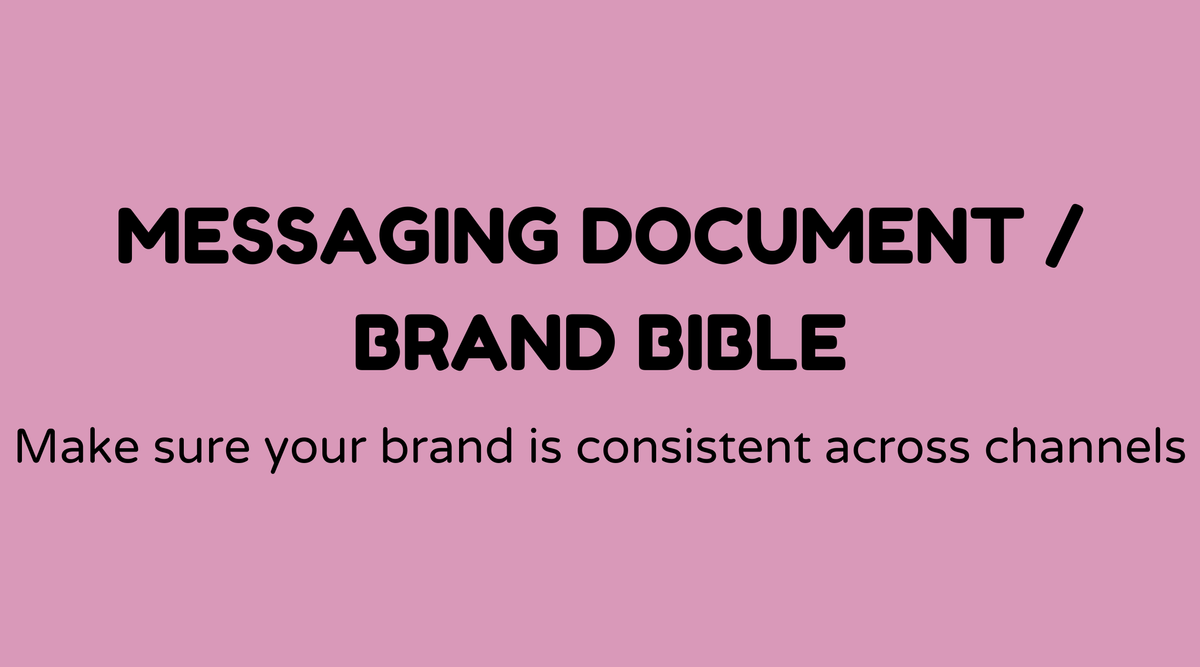Messaging document / brand bible

Overview of Messaging Document / Brand Bible:
Creating a Messaging Document or Brand Bible is akin to outlining your brand's personality. Think of it as a comprehensive guide that clarifies what your brand represents, from its tone to its visual style. It’s an essential resource for anyone seeking to maintain consistency across all communication formats. Typically, it includes sections on brand history, core mission, main messages, audience profiles, and brand voice.
Why Messaging Document / Brand Bible Matters:
Having a Messaging Document / Brand Bible helps avoid conflicting messages and supports the creation of a cohesive brand identity. Consider how confusing it would be if your preferred brand appeared with a different voice or look each time you encountered it. This guide helps every team member and potential collaborator understand exactly how to depict the brand. A well-maintained brand identity can greatly enhance consumer trust and loyalty. It serves as the foundation for marketing strategies, providing clarity and guidance.
What is Messaging Document / Brand Bible:
A Messaging Document or Brand Bible encapsulates all aspects of a brand's identity and expression. Its purpose is to ensure consistent communication and image representation wherever the brand is present. Here’s what it generally contains:
- Brand History: A narrative detailing the brand’s beginnings, growth journey, and aspirations.
- Core Mission and Values: A clear statement of the brand's purpose and the principles it embodies.
- Key Messages and Voice: Main talking points and the tone used across marketing channels.
- Visual Guidelines: Specifications covering logo usage, color schématiques, typography, and imagery.
- Audience Profiles: Detailed descriptions of target demographics and psychographics.
How do you do Messaging Document / Brand Bible:
Creating a Messaging Document / Brand Bible involves a series of steps. Here’s a simplified outline:
- Conduct a Brand Audit: Review the current state of brand elements - what’s effective and what needs adjustment.
- Define Core Values and Mission: Engage key stakeholders to finalize core beliefs and objectives.
- Develop Brand Voice and Messaging: Establish tone and main messages that resonate with target audiences.
- Create Visual Guidelines: Collaborate with designers to outline logo specifications, color schemes, and imagery.
- Outline Audience Segmentation: Use data to create in-depth personas of the intended audience.
- Draft and Review the Document: Write the document, align it with existing materials, and consult with brand stakeholders.
- Implementation and Training: Educate all relevant parties about the Brand Bible to ensure consistent use.
Sample Agenda of Messaging Document / Brand Bible Workshop:
Workshops are often held when crafting a Brand Bible, encouraging collaboration and creativity among key participants. Here's a sample agenda:
- Introduction (15 mins): Explain the purpose and significance of the Brand Bible.
- Brand Review (30 mins): Present current branding materials and gather input.
- Core Values Discussion (30 mins): Brainstorm and outline brand values and mission statement.
- Break (15 mins)
- Voice and Messaging Strategy (45 mins): Develop a unified messaging structure and characteristics.
- Visual Guidelines Session (45 mins): Collaborate on visual themes, including logos and colors.
- Audience Analysis (30 mins): Identify and describe target audience segments.
- Closing Remarks and Next Steps (30 mins)
Examples of Messaging Document / Brand Bible:
Brand bibles provide a reference for maintaining consistency. Notable examples include:
- Coca-Cola’s Brand Guidelines: Known for its enduring design principles and clear message of joy and refreshment.
- Airbnb’s Brand Manual: Seamlessly blends narrative with purpose, focusing on the ethos of belonging anywhere.
- Google’s Material Design Guidelines: A thorough guide that establishes high standards for design symmetry and clarity.
FAQs
What exactly is a Brand Bible?
A Brand Bible is a comprehensive guide to all aspects of a brand, covering its essence, messaging, and visual guidelines, to ensure uniform representation across all platforms.
Why are brand guidelines so important?
Consistency in branding aids in building recognition and trust among consumers. Guidelines ensure that each piece of communication aligns with the brand's core values.
Who should use the Messaging Document / Brand Bible?
Anyone involved in portraying or communicating the brand, from marketing to design teams, as well as external partners and agencies.
How often should the Brand Bible be updated?
It should be reviewed annually or whenever significant changes occur within the company, market, or target audience.
Can a small business benefit from a Brand Bible?
Absolutely! It provides small businesses with a clear identity and direction, helping them compete with larger entities.
What common mistakes should be avoided when creating a Brand Bible?
Avoid ambiguity in guidelines, overlooking audience diversity, and excluding key stakeholders from the development process.



